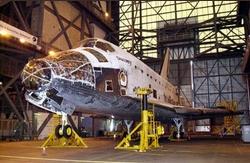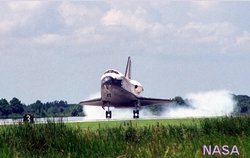Discovery Milestones
 The pace of preparations for Return
to Flight is picking up, with several key milestones in recent
weeks marking important progress in readying the Space Shuttle
Discovery for its next mission.
The pace of preparations for Return
to Flight is picking up, with several key milestones in recent
weeks marking important progress in readying the Space Shuttle
Discovery for its next mission.
Discovery is progressing after the completion of extensive
wiring for Return to Flight, as well as the transition from its
modification period to more regular processing at Kennedy Space
Center. Meanwhile, the first piece of Discovery’s twin Solid
Rocket Boosters was moved to a processing facility on site and
workers are installing several important components.
Though Discovery appears unchanged from the outside, the orbiter
is very different on the inside. The power-up on July 27 follows
safety improvements and modifications to enhance vehicle monitoring
during flight. Technicians have installed cabling for wing leading
edge sensors and to support a digital camera to document the
External Tank as it separates from Discovery. Wiring also has been
installed to support a boom extension for the Shuttle's robotic
arm, which will provide the ability to inspect nearly all of the
outside areas of the orbiter's Thermal Protection System in
detail.
On August 9, the first segment of the Solid Rocket Boosters
designated for Discovery's flight was moved to the Rotation
Processing and Surge Facility at KSC. The aft skirt -- the bottom,
skirt-shaped section of the boosters -- will have two other
components installed: an aft motor segment and an External Tank
attach ring. Next month, the structure will move to the Vehicle
Assembly Building for stacking operations.

Engineers and technicians have applied many of the modifications
laid out in NASA's Implementation Plan for Space Shuttle Return to
Flight and Beyond.
"The Vision for Space Exploration begins with safely returning
the Shuttle to flight and resuming assembly of the International
Space Station," said Michael Kostelnik, Deputy Associate
Administrator for International Space Station and Space Shuttle
Programs. "These processing milestones show we're moving toward
that goal."
Eighty-eight sensors will be installed on each wing. Sixty-six
will measure acceleration and impact data and 22 will take
temperature data during Discovery's climb to orbit. Ongoing tests
have demonstrated these sensors can detect very small impacts.
Wiring has been added to the umbilical well under Discovery to
accommodate a digital camera, which will transmit External Tank
photos to the ground quickly. When the tank is separated from the
Shuttle, an automatic sequence will capture 24 images at one frame
every 1.5 seconds. These images will be downlinked to Mission
Control at NASA's Johnson Space Center in Houston for review and
analysis.
"The Program's first line of defense was to redesign the
External Tank so that debris of a critical size never impacts the
orbiters again," said Bill Parsons, Space Shuttle Program Manager.
"We have done that. Combined with ground, airborne and onboard
cameras and lasers, the addition of sensors will provide more
detection and inspection capability than the Program has ever
had."
 The visible progress in Florida and
other locations around the country parallels work by the Space
Shuttle Program and its many contractor and subcontractor teams in
response to the Columbia Accident Investigation Board's
recommendations. NASA's Space Flight Leadership Council is the
internal body reviewing the Shuttle Program's work, and the
Stafford-Covey Return to Flight Task Group provides independent,
external oversight. NASA is working toward a launch planning window
for Discovery that opens in March 2005.
The visible progress in Florida and
other locations around the country parallels work by the Space
Shuttle Program and its many contractor and subcontractor teams in
response to the Columbia Accident Investigation Board's
recommendations. NASA's Space Flight Leadership Council is the
internal body reviewing the Shuttle Program's work, and the
Stafford-Covey Return to Flight Task Group provides independent,
external oversight. NASA is working toward a launch planning window
for Discovery that opens in March 2005.
Since September 2002, Discovery has been in a
regularly-scheduled Orbiter Major Modification period for
maintenance and upgrades. In addition to the Return to Flight work,
more than 100 modifications have been performed, including the
addition of the Multi-functional Electronic Display System, or
"glass cockpit."
"Along with the power up, we have passed several significant
milestones during the last few months with the installation of the
Forward Reaction Control System, the Reinforced Carbon-Carbon nose
cap and wing leading edge panels," Discovery Vehicle Manager
Stephanie Stilson said. "I am very optimistic we are moving toward
a launch next spring."
 ANN's Daily Aero-Linx (04.13.24)
ANN's Daily Aero-Linx (04.13.24) ANN's Daily Aero-Term (04.13.24): Beyond Visual Line Of Sight (BVLOS)
ANN's Daily Aero-Term (04.13.24): Beyond Visual Line Of Sight (BVLOS) Airborne 04.09.24: SnF24!, Piper-DeltaHawk!, Fisher Update, Junkers
Airborne 04.09.24: SnF24!, Piper-DeltaHawk!, Fisher Update, Junkers Aero-News: Quote of the Day (04.14.24)
Aero-News: Quote of the Day (04.14.24) ANN's Daily Aero-Term (04.14.24): Maximum Authorized Altitude
ANN's Daily Aero-Term (04.14.24): Maximum Authorized Altitude





